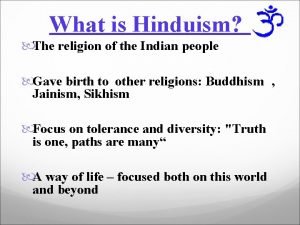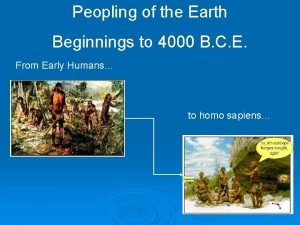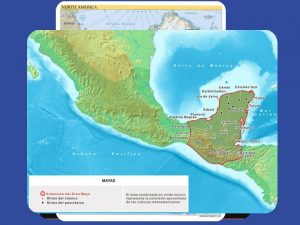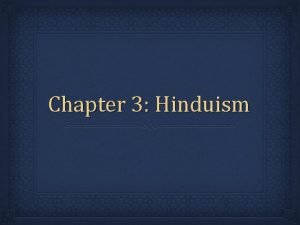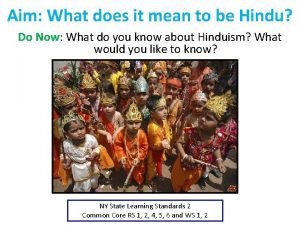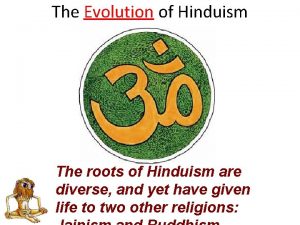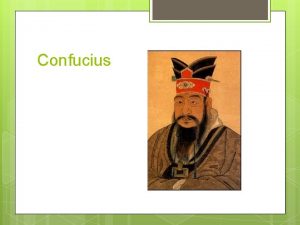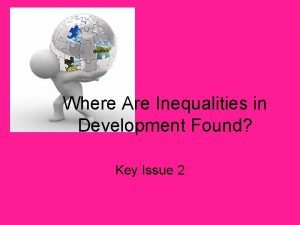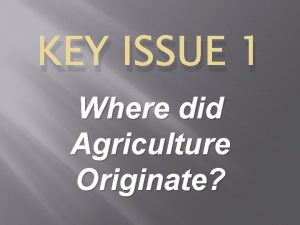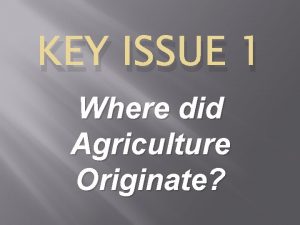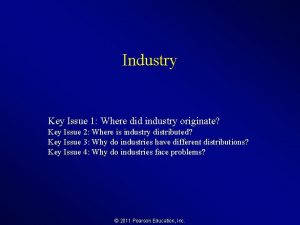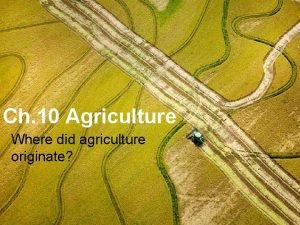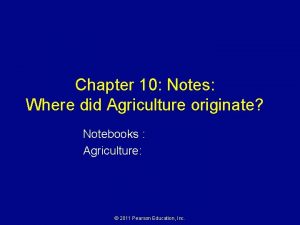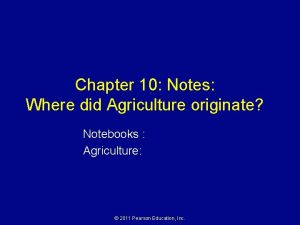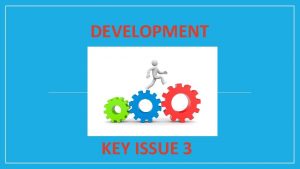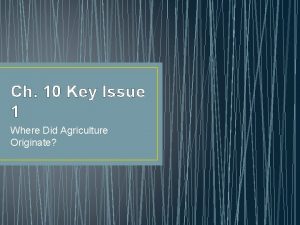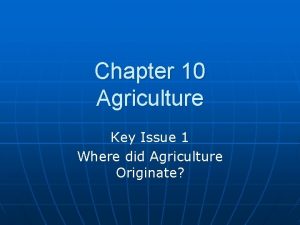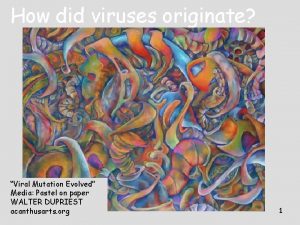KEY ISSUE 1 Where did Agriculture Originate Agriculture











































- Slides: 43

KEY ISSUE 1 Where did Agriculture Originate?

Agriculture is deliberate modification of Earth’s surface through cultivation of plants and rearing of animals to obtain sustenance or economic gain.

Origins of agriculture cannot be documented with certainty, because it occurred before recorded history.

Prior to the advent of agriculture, all humans likely obtained needed food through hunting and gathering.

People practicing hunting & gathering usually lived in groups of 50 or less, and relocated regularly along with changing seasons. Geographers believe hunters and gatherers utilized a gendered division of labor

Today, only a quarter million people practice H&G, living on the farthest margins of modern society. A modern example are the BUSHMEN of Namibia/ Botswana

The Agricultural Revolution was when humans first domesticated plants and animals, removing reliance on hunting and gathering. Cave painting of humans with domesticated animals

The Agricultural Revolution allowed humans to • Create permanent settlements • Have greater food security • Host larger populations

Discovery of Agriculture – some disagreement on causes ACCIDENT- Humans noticed by accident that discarded seeds sprouted new plants, and responded EXPERIMENTATION- Humans deliberately experimented with the planting of crops, eventually finding methods that worked It was probably a combination of both!

� 3 Agricultural Revolutions rd ND � 3 � 2 Coincided w/ Industrial Rev’n (Late 1700 s- early 1800 s) new farm implements (like steel plow) lead to much larger farm sizes and less labor. � Began in mid-20 th century with advanced technology and bioengineering. � Further reduced labor demand; far higher farm output. �

Agriculture is believed to have developed in multiple hearts around 9 -10, 000 years ago.

Crop Hearths (early crops, by region) Sub-Saharan Africa: Sorghum, yams, millet, and rice East Asia: Rice and millet

Crop Hearths (early crops by region) Latin America: Beans, cotton, potato; most importantly maize (corn) Southwest Asia: barley, wheat, lentil, and olive

Animal Domestication Southwest Asia is credited with domesticating many of the most important stock animals around 8, 000 years ago, including cattle, goats, pigs, and sheep

DOGS were first domesticated around 12, 000 years ago in SW Asia- predating the agricultural revolution. They may have been used by huntergatherers for hunting and security

HORSES were domesticated in Central Asia, their diffusion largely followed the diffusion of the Indo. European language family. This lends support to Gimbutas’ Nomadic Warrior Hypothesis.

Subsistence v. Commercial

SUBSISTENCE AGRICULTURE is the production of food primarily for consumption by the farmer’s kin (not for sale).

COMMERCIAL AGRICULTURE is the large-scale production of food for sale off the farm.

Several characteristics distinguish subsistence agriculture from commercial agriculture.

Small-scale and local, subsistence agriculture is practiced primarily in the developing world.

Large-scale, expensive, and technology-intensive, commercial agriculture is primarily practiced in the developed world.

FARMERS IN THE LABOR FORCE In the developing world, farmers constitute ≥ 44% of the labor force, compared to ≤ 5% in most developed countries.

In the USA and Canada, farmers are only 2% of the labor force- but these countries produce enough crops to provide an export surplus.

Farmers in the Labor Force - Global percentages

FARM SIZE Commercial farms are FAR larger than subsistence farms. Farms in the US average 161 hectares (418 acres); in China, they average just 1 hectare (2. 5 acres).

USE OF MACHINERY Commercial farming is dependent on expensive technology, while subsistence farming is accomplished through brute physical force.

KEY ISSUE 2 Why do People Consume Different Foods?

The way the people produce and consume foods provides one of the starkest contrasts between the developed and developing world.

Diet is determined by. Level of Development • People in the developed world eat MORE, from MORE SOURCES Physical Conditions • Determines what can be grown and consumed based on environment Cultural Factors

DIETARY ENERGY CONSUMPTION is the amount of food an individual consumes; this is measured in KCALS, or CALORIES.

Most calories are obtained through the consumption of CEREAL CROPS - grasses that bear edible seeds (GRAINS).

WHEAT, RICE, and MAIZE are the most commonly consumed cereal crops. Regional consumption trends are clear.

VENEZUELA is the only country where most calories are secured through SUGAR CONSUMPTIONthough the country is in a MAJOR FOOD SHORTAGE today.

Disparities exist between how the developed and developing world acquires needed PROTEIN. MEAT CONSUMPTION provides most protein in the developed world. CEREAL GRAINS provide most protein in the developing world.

SOURCES OF PROTEIN

% PROTEIN FROM MEAT

FOOD SECURITY is access to safe and nutritious food required for an active and healthy life. Approximately 1 in 8 people in the

People need to eat 1, 800 KCAL per day to lead a healthy life. In the US, average consumption is 3, 800 per day; in the developing world, it is 2, 400. Many very poor countries hover near the recommended minimum.

Undernourishmen t is dietary energy consumption that is continuously below the minimum requirement for maintaining a healthy life.

The UN estimates that 870 million people suffer from undernourishment- 99% of whom live in the developing world.

Global Distribution of UNDERNOURISHMENT

State/Regional Distribution of UNDERNOURISHMENT
 Where did agriculture originate
Where did agriculture originate How did agriculture originate
How did agriculture originate The vikings were sailors came
The vikings were sailors came Where did the word volcano originate from
Where did the word volcano originate from Where did hinduism originate
Where did hinduism originate Whiteboard viking
Whiteboard viking What god does hinduism believe in
What god does hinduism believe in Peopling of the earth
Peopling of the earth Where did christianity originate
Where did christianity originate Viking boots
Viking boots Origin of limericks
Origin of limericks Where did hinduism originate?
Where did hinduism originate? Latin rock artists
Latin rock artists Where did hinduism originate from
Where did hinduism originate from Explain eusociality. how did eusociality originate?
Explain eusociality. how did eusociality originate? Hinduism map
Hinduism map Where did hinduism originate
Where did hinduism originate Where did chickens originate columbian exchange
Where did chickens originate columbian exchange The history of clowns
The history of clowns Where did christianity originate
Where did christianity originate Where did hinduism originate map
Where did hinduism originate map Where did hinduism originate
Where did hinduism originate Art history impressionism
Art history impressionism Where did calvinism originate
Where did calvinism originate Where did vikings originate
Where did vikings originate Where did hinduism originate
Where did hinduism originate Where did yellow fever originate
Where did yellow fever originate Where did the druids originate
Where did the druids originate Ancient greece olympics opening ceremony
Ancient greece olympics opening ceremony Where did anglo saxons originate from
Where did anglo saxons originate from Anglo saxon days of the week
Anglo saxon days of the week Where did santa clause originate
Where did santa clause originate Where did sour patch originate
Where did sour patch originate Who is the founder of judo
Who is the founder of judo When did confucianism begin
When did confucianism begin Javanese shadow puppets
Javanese shadow puppets Where did modern dance come from
Where did modern dance come from Basic beliefs of shintoism
Basic beliefs of shintoism Give up one’s views or beliefs
Give up one’s views or beliefs Revenue streams example business model canvas
Revenue streams example business model canvas Business model canvas tripadvisor
Business model canvas tripadvisor Where are inequalities in development found
Where are inequalities in development found Key issue 2 why are situation and site factors important
Key issue 2 why are situation and site factors important Key issue 1 why do services cluster downtown
Key issue 1 why do services cluster downtown




